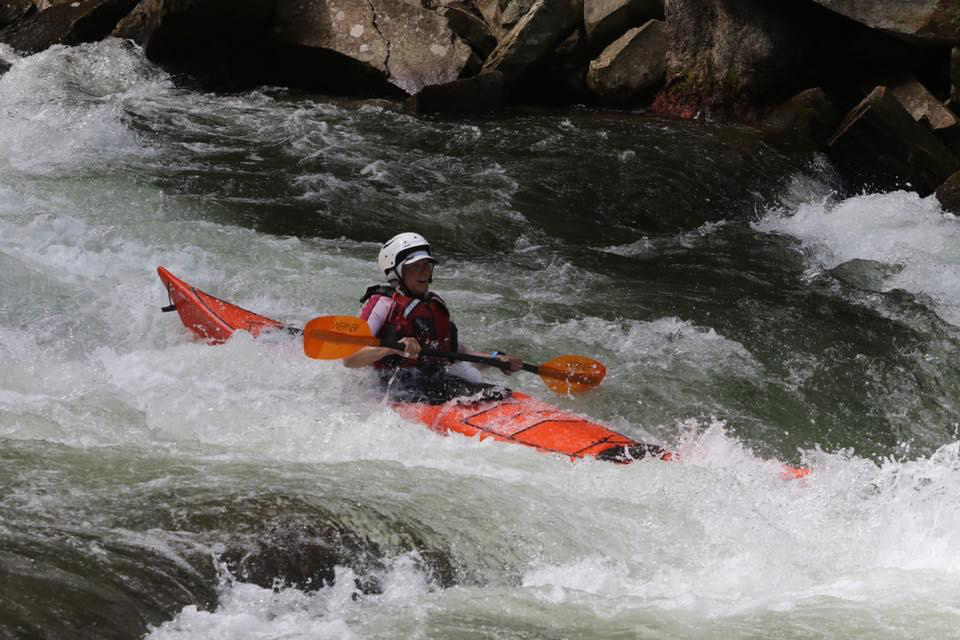The Romany Rotomolds
- Randi Kruger

- Dec 4, 2023
- 4 min read
Inevitably, in every paddler’s life, there will come a time when a plastic boat is a useful tool. Whether for rock gardening, river running, or just banging around with students, plastic has endured as a trusted material from which to craft a kayak. Nigel Dennis added rotomold to the NDK line with the introduction of the Romany Surf RM, about a dozen years ago.

NDK Sport Photo credit R. Kruger
The Romany Surf RM was born directly from the unrivalled Romany Surf. Its name has had several re-writes though, and is now labelled the NDK Sport. In catalogs it is still listed as the Romany Sport RM. I refer to this boat as the Sport, and will throughout this article.
The Sport is directly related to the Surf. It has the same knee bumps, length and similar rocker. It will serve for me to compare the two directly. Paddlers who enjoy the Surf will find the cockpit opening narrower and shorter. Once inside though, many find it just as roomy, if not a tad roomier. It has moderately defined chine, perhaps a bit more than the Surf. The Sport will easily carry paddlers from 180 to 230 pounds, similar to the Surf. It behaves nicely loaded with some gear, even with a top weight paddler. It also accommodates the paddler with larger feet, also quite like the Surf.
It offers the advantage of a composite coaming, rather than rotomold, and the seat is the same composite Performance seat found in most of NDK’s line. The single layer roto mold construction is surprisingly stiff, allowing for crisp control and acceleration. The construction is durable, and the rotomold layup is indeed quite stiff for a plastic boat.
In 2018 NDK introduced the smaller version of the boat, the Sportive. It offers all the same features and advantages of the Sport, but in a smaller package.
Both the Sport and the Sportive were designed for rock gardening and coastal play. They both handle easily, taking input and responding quickly. They have defined rocker, making them easy to turn, and offer capable handling in surf. They are both solid performers in waves, making them a favorite for wave play. They were designed with smaller cockpit openings than most other NDKs, something like a 1.2 cockpit on the “Seals” scale. The smaller cockpit is ideal for those wishing to drop pour overs and ledges, making skirt implosion less likely.

Sportive logo. Photo credit R. Kruger

Green Sport and Pink Sportive. Photo credit R. Kruger
The Sportive is the petite version of the Sport. It is designed for the slighter, shorter paddler. Where the Sport is 16 feet 4 inches in length, the Sportive is 15 feet 7 inches. The deck height drops from 11.5 inches at the front of the cockpit to 11 inches on the Sportive. The Sportive is certainly smaller inside as well. The real tell on deck height, however, is in the foot room category. For example, my women’s size 9 (US) feet in booties barely fit in the boat with the foot pegs placed near the end of the peg tracks.
There are subtle differences in the two boats. As you can see from the above pic, the Sportive has a tad less rocker than the Sport. Its chine is defined, and yet also has a more defined keel line bow to stern. The amount of volume lost in downsizing to the Sportive is noticeable. It behaves best with the sub-170 pound paddler, and only a light load of gear. The cockpit opening is even smaller on the Sportive.

Left Sport, right Sportive. Photo credit R. Kruger
The overall up side of both models: performance, durability, quality, stiffness.
The downside: they don’t fit every paddler. They are not lighter than the comparable composite boat in the NDK line. The smaller cockpit opening, ideal for dropping pour overs, means paddlers with less mobility will struggle to enter and exit gracefully. Paddlers have noted they are not as “fast” as composite boats when touring, although they accelerate well. This is not the boat to grind out a twenty mile trip with a bunch of 17 foot composite boats. It is not a touring boat, and does not shine in flat water.

Tide race on Long Island. Orange Sportive, Green Sport. Photo credit R. Kruger
Where these boats shine is doing the kinds of things we don’t want to do in our beautiful composite boats. While not indestructible, they are certainly sturdier and less prone to the kinds of damage that plague composite boats when used in rocks, and with students. Because they offer nearly the same performance as a composite NDK, there isn’t much of a down side to paddling them in appropriate conditions.
Rob and I use the Sport and Sportive constantly. They have become our preferred boats for travelling and teaching. I personally love running Class 2 & 3 white water in my Sportive. I enjoy paddling the Sport just as much as the Sportive, and will add a Sport to my quiver here shortly.
Like me, Dawn Stewart owns a Sportive and has run some white water in it. Dale Williams uses Sports in his livery for visiting instructors, and uses one himself when traveling. Jeff Atkins has used one but finds it a tad tight.

Dawn dropping into a pour over in her Sportive. Photo credit NOC
If I haven’t convinced you to look at these models before you buy your next plastic boat, you probably aren’t going to need what this boat has to offer. If you do need this kind of performance and durability, I’d advise you to give it a long hard look. Or borrow one of mine and see for yourself!
~Randi Kruger






Comments